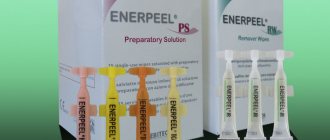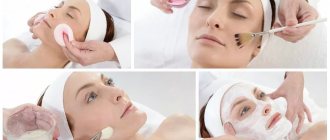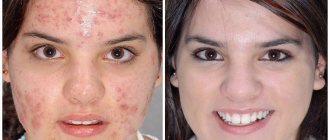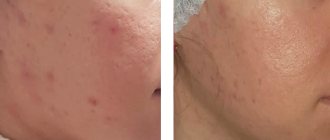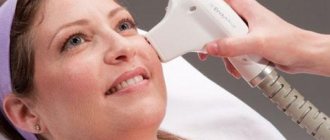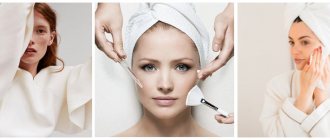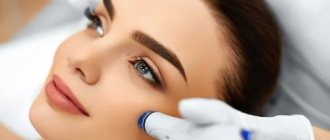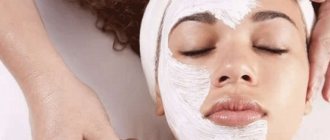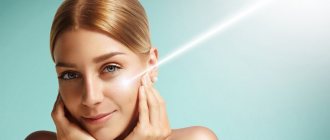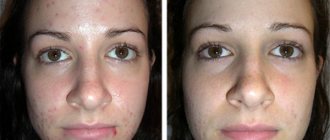- Department of Aesthetic Medicine
Department of Aesthetic Medicine » - Classic cosmetology
Classic cosmetology »
- Services
Services "
- Chemical peeling of the face
Chemical peeling of the face is a new birth of your skin. This is an opportunity to refresh and cleanse the face, even out the texture, and eliminate fine wrinkles in just a few procedures. After the sessions, the skin cells will be completely renewed, the face will acquire a beautiful color, smooth and well-groomed appearance .
At the RAMI Clinic, chemical peelings are performed by cosmetologists of the highest category. During your consultation, specialists will select the most effective peeling option for you and prescribe the required number of procedures.
With a professional approach, chemical peels are one of the most effective procedures that eliminate wrinkles and restore the skin to a beautiful and healthy appearance.
Indications for use of Chemical peels
Chemical peeling is recommended for any skin type, in cases such as:
- oily problem skin (or combination);
- dry, dehydrated skin with fine wrinkles;
- enlarged pores;
- uneven skin surface, scars, scars, post-acne;
- skin pigmentation;
- keratosis;
- preparation for skin plastic surgery.
Chemical peels come in different types. They are used depending on the skin type and the nature of the problem.
Possible side effects
- a pustular rash due to bacteria coming into contact with the skin during or after peeling and the development of inflammation, usually goes away on its own when the protective functions of the skin are restored, or is removed during the next pre-peeling cleansing;
- exacerbation of herpes - this reaction to peeling occurs quite often, therefore, if you have herpes rashes, it is better to take a course of acyclovir as a preventive measure before the procedure;
- hyperpigmentation is the appearance or intensification of an existing one, sometimes this is an individual reaction of the skin to peeling, but most often occurs when sunscreen is neglected after the procedure.
Back to the beginning of the article
Types of chemical peelings at the RAMI Clinic
All chemical peels can be divided into 3 types :
- superficial chemical peeling - affects only the epidermis (top layer of skin);
- medium chemical peeling - effects on the epidermis and dermis (surface layers);
- deep chemical peeling - affects the lower layers of the skin.
At the RAMI Clinic, only the most effective and reliable chemical peels are used for the procedure:
Popular types of laser treatment?
Fraxel Laser Treatment (Non-Ablative): This type of laser works best on mild to moderate acne scars and fine lines, triggering cell regeneration and collagen production.
CO2/carbon dioxide resurfacing (ablative): suitable for removing deep wrinkles and severe acne scars. This type of laser is not good at all for treating skin redness.
Erbium resurfacing (ablative): The ablative erbium laser is a gentler and less intrusive laser treatment than CO2-. The laser penetrates the epidermis (outer layer of skin) and also stimulates collagen production. It is often used to reduce wrinkles, creases and age spots.
Peeling with fruit acids. Chemical peeling based on glycolic acid
Chemical peeling based on glycolic acid (25%, 50%) is the most common type of superficial peeling (affects only the top layer of skin). It is carried out using products based on glycolic acid. It belongs to the group of alpha hydroxy acids (or fruit acids). Found in beets, sugar cane and unripe grapes.
Glycolic acid can have an exfoliating effect, therefore it is widely used in peeling to solve problems such as fine wrinkles, enlarged pores, hyperpigmentation, post-acne, and increased activity of the sebaceous glands. Due to its low molecular weight, it easily penetrates the skin, where it affects the physiological state of the epidermis. In response to the damage caused by glycolic acid, the skin begins to actively launch recovery processes: it is renewed, moisturized, and becomes elastic. Due to this , a beautiful complexion is restored, all nervousness, fine wrinkles and acne go away .
Due to its superficial effect, glycolic peeling requires minimal recovery time.
Retinoic yellow peeling
Retinoic yellow peel (Retinol yellow peel, ampoule Spain) is one of the most popular medium peels. The peeling is based on retinoic acid, which is yellow in color (hence the name of the peel). The procedure can be performed on various skin types; it is recommended for the first signs of aging, hyperpigmentation, as well as for uneven skin surfaces (scars, cicatrices).
Retinoic acid is a fat-soluble acid and antioxidant. Upon penetration into the skin, it affects the epidermis, regulating the processes of keratinization and pigmentation. It restores the intercellular matrix, which gradually collapses with age (and as a result, wrinkles appear). One of the features of yellow peeling is that retinoic acid significantly reduces the level of sebum secretion. As a result of the procedure, blood and lymph circulation in the epidermis improves, the skin is cleansed, restored and takes on a healthy and well-groomed appearance !
Yellow peeling
Yellow peeling (YELLOV PEEL, cream mask USA) is one of the most gentle chemical peels. Yellow Peel is based on retinoic acid, which stimulates skin cells to produce collagen and elastin.
The Yellow Pell cream mask also contains ascorbic, phytic and other acids, which enhance the effect of retinoic acid and help eliminate hyperpigmentation. Yellow chemical peeling YELLOV PEEL is suitable for any skin type, it can even be performed in the eyelid area . Due to its gentle action, the rehabilitation period is only 2 - 4 days. The results are amazing: fine wrinkles are smoothed out, the skin becomes fresh and elastic , and hyperpigmentation disappears.
Milk peeling
Milk peeling is a “superficial” peeling. It is based on lactic acid, which improves blood microcirculation, ensures cell renewal, tightens and moisturizes the skin. Milk peeling is one of the most gentle chemical procedures. It is low-traumatic and has no side effects.
The uniqueness of this peeling is its effectiveness in a short time . Only 3 to 6 procedures are required. At the same time, the results exceed expectations: the skin is smoothed, takes on a healthy, juicy appearance, its tone and elasticity are restored. Milk peeling is indicated even for sensitive skin. The antioxidants included in the composition have an anti-inflammatory effect, so the procedure is effective for the treatment of acne .
Peeling Super Lift
Super Lift Instant Lifting is a chemical peeling procedure that instantly revitalizes the skin. The biocomplexes contained in the drug restore the healthy structure of the dermis and have a powerful lifting effect. It is based on fruit acids and phytoestrogens, which easily exfoliate dead skin cells and effectively smooth the skin surface. Super Lift peeling will provide a healthy, beautiful complexion and a smooth, delicate skin surface. The procedure is atraumatic, so it is suitable even for sensitive skin.
ABR peeling
ABR peeling is a peeling based on fruit acids with the addition of retinol. Refers to the middle type of procedure. Has a gentle and gentle effect. Effective against premature aging, problem skin, helps with acne, post-acne and hyperpigmentation.
The peeling contains alpha and beta acids (fruit and salicylic), which gently exfoliate dead skin cells, stimulate regenerative processes, as a result, smooth the surface and regulate sebum secretion. Thanks to the active stimulation of the production of collagen and elastin (fibers of “skin youth”), after the procedure, fine wrinkles are smoothed out and complexion improves . ABR peeling can be recommended even for teenagers to eliminate acne on the face.
TCA peeling
TCA peeling can be superficial, medium and deep. It is based on trichloroacetic acid, which helps get rid of wrinkles, hyperpigmentation, acne, and scars . The peeling also contains lyctocaine, which has a pronounced anti-inflammatory effect. This type of peeling is more suitable for patients with fair skin, as the results are more obvious. The rehabilitation period lasts 2 weeks, and the effect after the procedure will meet all expectations. The skin will become smooth, smooth, fine wrinkles will disappear, and a beautiful, fresh appearance will be restored.
What is coral peeling made of?
The main element of this peeling is Red Sea corals crushed into dust. It is this dust that serves as an abrasive - grinding - substance that mechanically destroys and scrapes off the top dead layer of skin.
But coral chips are not just small solid particles, they are also salts and minerals of the Red Sea, and they also have an effect on the skin. And besides corals, the peeling includes
- Dead Sea salt, whose water is known for its healing properties for the skin,
- and Amazonian herbs containing vitamins, essential oils, phytoncides
- and many other biological active substances.
Back to the beginning of the article
How is Chemical Peeling Performed?
At the RAMI Clinic, chemical peelings are performed by cosmetologists of the highest category. Before the session (10-14 days in advance), it is recommended to undergo pre-peeling preparation in order to prepare the skin for “stress”. For this purpose, special acid-based cleansing gels are used. The pre-peeling preparation procedure is prescribed by a cosmetologist.
A chemical peeling session lasts from 30 minutes to 2 hours (depending on the type of peeling). The first thing the procedure begins with is removing makeup using special solutions. Next, the cosmetologist will put on protective glasses and apply a peeling agent to your facial skin with smooth movements. Next, the mask is kept on the skin for a certain time. The patient may feel a slight tingling sensation, which will soon go away.
Coral peeling procedure
Pre-peeling preparation is not required; sometimes pre-cleaning is carried out.
After cleansing, a paste of coral dust with a special solution is applied to the face. The composition smells very unpleasant, like algae and fish.
This paste is rubbed into the skin with light massage movements.
The procedure is very painful!
It seems as if the skin is being scraped with sandpaper or crushed glass, and millions of microscopic needles are being driven under it.
Fortunately, this does not last long, usually no more than 2-3 minutes for the first time, unfortunately, after finishing the massage and washing off the mixture, the pain does not stop, since some of the coral dust remains on the skin, where it should continue to work.
After peeling, cold wet wipes are placed on the face - the cold muffles pain and reduces future redness of the skin.
Then the face is treated with a special adhesive composition that prevents microbes from entering the injured skin and at the same time retains coral particles in it.
After this, a foundation based on healing clay is usually applied, which does not need to be washed off until the next day.
Back to the beginning of the article
Result after chemical peeling
After the procedure, there will be redness and swelling, which will soon disappear. Then there will be a feeling of tightness of the skin and crusts will appear that will begin to peel off.
The length of the rehabilitation period varies. It all depends on the type of peeling performed. At the same time, the result is worth these expectations.
After a certain number of days, the skin will be completely renewed, small wrinkles and unevenness will disappear. The face will acquire a beautiful, fresh and well-groomed appearance. Acne, scars and hyperpigmentation will disappear. You will radiate youth and tenderness!
The main thing is to follow all the recommendations of the cosmetologist and the result will exceed all your expectations!
We recommend watching:
| Recommendations from a cosmetologist at the RAMI Clinic on chemical peelings |
If you are really looking for your doctor...
Recovery period
Lasts from two days to a week. Skin after peeling
- red, like a sunburn,
- painful (we remember that there were sharp particles of coral left in it),
- edematous,
- tightened.
It is very painful to touch her. If the procedure was performed not on the face, but, for example, on the back, one can only sympathize with the patient. These days, it is recommended to change the pillowcase on the pillow or the entire set of bed linen daily, after carefully ironing it to minimize the risk of germs getting on injured skin.
After 2-3 days, it begins to peel off greatly, sometimes becoming literally like a terry towel, in other cases coming off in large flaps, like after being burned in the sun.
In places, crusts form on the skin that cannot be touched.
Maintaining a normal lifestyle for several days becomes problematic, since your appearance may cause confusion among others.
Back to the beginning of the article
